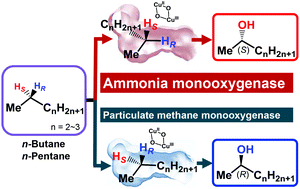Discrimination of the prochiral hydrogens at the C-2 position of n-alkanes by the methane/ammonia monooxygenase family proteins†
Abstract
The selectivity of ammonia monooxygenase from Nitrosomonas europaea (AMO-Ne) for the oxidation of C4–C8n-alkanes to the corresponding alcohol isomers was examined to show the ability of AMO-Ne to recognize the n-alkane orientation within the catalytic site. AMO-Ne in whole cells produces 1- and 2-alcohols from C4–C8n-alkanes, and the regioselectivity is dependent on the length of the carbon chain. 2-Alcohols produced from C4–C7n-alkanes were predominantly either the R- or S-enantiomers, while 2-octanol produced from n-octane was racemic. These results indicate that AMO-Ne can discriminate between the prochiral hydrogens at the C-2 position, with the degree of discrimination varying according to the n-alkane. Compared to the particulate methane monooxygenase (pMMO) of Methylococcus capsulatus (Bath) and that of Methylosinus trichosporium OB3b, AMO-Ne showed a distinct ability to discriminate between the orientation of n-butane and n-pentane in the catalytic site.


 Please wait while we load your content...
Please wait while we load your content...